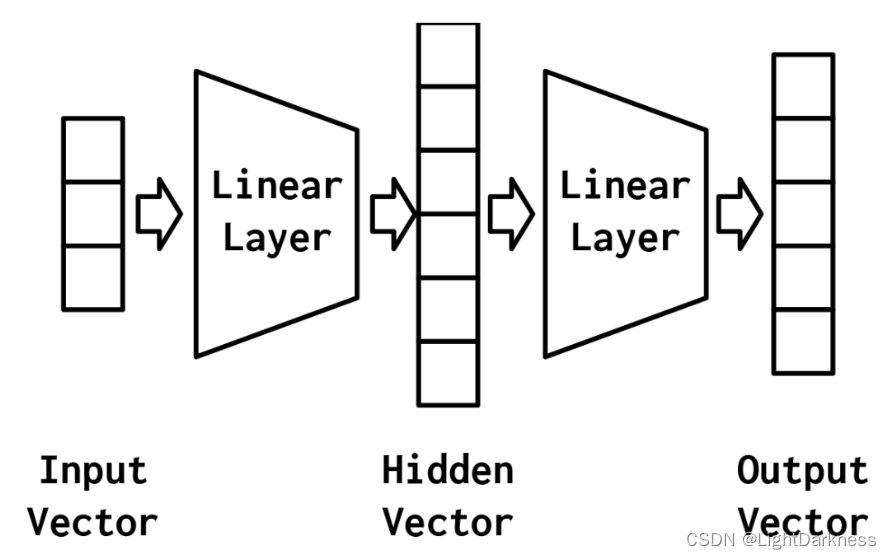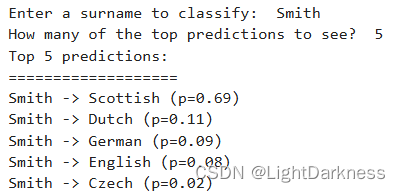一、实验介绍
1.1实验内容
感知器是现存最简单的神经网络,是神经网络的基础,而他的一个缺点是不能学习数据中存在的一些非常重要的模式,当数据点存在非此即彼(XOR)的情况时,在这种情况下,决策边界非线性可分,此时感知器失败。
因此在本次实验中将探索前馈网络神经模型,以及两种前馈神经网络:多层感知机和卷积神经网络。
多层感知机在结构上扩展了简单感知机,将多个感知器分组在一个单层,并将多个层叠加在一起。
卷积神经网络,是在处理数字信号时受窗口滤波器的启发,通过窗口特性,卷积神经网络能够在输入中学习局部化模式,这不仅使其成为计算机视觉的主轴,而且是检测单词和句子等序列数据中的子结构的理想候选。
在本实验中,多层感知器和卷积神经网络被分组在一起,因为它们都是前馈神经网络,并且与另一类神经网络——递归神经网络(RNNs)形成对比,递归神经网络(RNNs)允许反馈(或循环),这样每次计算都可以从之前的计算中获得信息。
1.2实验要点
通过实例“带有多层感知机的姓氏分类”,掌握多层感知机在分层计算中的运用。
掌握每种类型的神经网络层对它所计算的数据张量的大小和形状的影响。
1.3实验环境
Python 3.6.7
二、多层感知机(MLP)
多层感知器(MLP)被认为是最基本的神经网络构建模块之一。最简单的MLP是对感知器的扩展。感知器将数据向量作为输入,计算出一个输出值。在MLP中,许多感知器被分组,以便单个层的输出是一个新的向量,而不是单个输出值。在PyTorch中,正如您稍后将看到的,这只需设置线性层中的输出特性的数量即可完成。MLP的另一个方面是,它将多个层与每个层之间的非线性结合在一起。
最简单的MLP,如图所示,由三个表示阶段和两个线性层组成。第一阶段是输入向量。这是给定给模型的向量。在“示例:对餐馆评论的情绪进行分类”中,输入向量是Yelp评论的一个收缩的one-hot表示。给定输入向量,第一个线性层计算一个隐藏向量——表示的第二阶段。隐藏向量之所以这样被调用,是因为它是位于输入和输出之间的层的输出。我们所说的“层的输出”是什么意思?理解这个的一种方法是隐藏向量中的值是组成该层的不同感知器的输出。使用这个隐藏的向量,第二个线性层计算一个输出向量。在像Yelp评论分类这样的二进制任务中,输出向量仍然可以是1。在多类设置中,将在本实验后面的“示例:带有多层感知器的姓氏分类”一节中看到,输出向量是类数量的大小。虽然在这个例子中,我们只展示了一个隐藏的向量,但是有可能有多个中间阶段,每个阶段产生自己的隐藏向量。最终的隐藏向量总是通过线性层和非线性的组合映射到输出向量。

mlp的力量来自于添加第二个线性层和允许模型学习一个线性分割的的中间表示——该属性的能表示一个直线(或更一般的,一个超平面)可以用来区分数据点落在线(或超平面)的哪一边的。学习具有特定属性的中间表示,如分类任务是线性可分的,这是使用神经网络的最深刻后果之一,也是其建模能力的精髓。
MLP除了简单的感知器之外,还有一个额外的计算层。用PyTorch的两个线性模块可以实例化这个想法,线性对象被命名为fc1和fc2,它们遵循一个通用约定,即将线性模块称为“完全连接层”,简称为“fc层”。除了这两个线性层外,还有一个修正的线性单元(ReLU)非线性,它在被输入到第二个线性层之前应用于第一个线性层的输出。由于层的顺序性,必须确保层中的输出数量等于下一层的输入数量。使用两个线性层之间的非线性是必要的,因为没有它,两个线性层在数学上等价于一个线性层4,因此不能建模复杂的模式。MLP的实现只实现反向传播的前向传递。这是因为PyTorch根据模型的定义和向前传递的实现,自动计算出如何进行向后传递和梯度更新。
import torch.nn as nn
import torch.nn.functional as F
class MultilayerPerceptron(nn.Module):
def __init__(self, input_dim, hidden_dim, output_dim):
"""
Args:
input_dim (int): the size of the input vectors
hidden_dim (int): the output size of the first Linear layer
output_dim (int): the output size of the second Linear layer
"""
super(MultilayerPerceptron, self).__init__()
self.fc1 = nn.Linear(input_dim, hidden_dim)
self.fc2 = nn.Linear(hidden_dim, output_dim)
def forward(self, x_in, apply_softmax=False):
"""The forward pass of the MLP
Args:
x_in (torch.Tensor): an input data tensor.
x_in.shape should be (batch, input_dim)
apply_softmax (bool): a flag for the softmax activation
should be false if used with the Cross Entropy losses
Returns:
the resulting tensor. tensor.shape should be (batch, output_dim)
"""
intermediate = F.relu(self.fc1(x_in))
output = self.fc2(intermediate)
if apply_softmax:
output = F.softmax(output, dim=1)
return output由于MLP实现的通用性,可以为任何大小的输入建模。为了演示,我们使用大小为3的输入维度、大小为4的输出维度和大小为100的隐藏维度。请注意,在print语句的输出中,每个层中的单元数很好地排列在一起,以便为维度3的输入生成维度4的输出。
batch_size = 2 # number of samples input at once
input_dim = 3
hidden_dim = 100
output_dim = 4
# Initialize model
mlp = MultilayerPerceptron(input_dim, hidden_dim, output_dim)
print(mlp)我们可以通过传递一些随机输入来快速测试模型的“连接”,如示例4-3所示。因为模型还没有经过训练,所以输出是随机的。在花费时间训练模型之前,这样做是一个有用的完整性检查。请注意PyTorch的交互性是如何让我们在开发过程中实时完成所有这些工作的,这与使用NumPy或panda没有太大区别:
import torch
def describe(x):
print("Type: {}".format(x.type()))
print("Shape/size: {}".format(x.shape))
print("Values: \n{}".format(x))
x_input = torch.rand(batch_size, input_dim)
describe(x_input)综上所述,mlp是将张量映射到其他张量的线性层。在每一对线性层之间使用非线性来打破线性关系,并允许模型扭曲向量空间。在分类设置中,这种扭曲应该导致类之间的线性可分性。另外,可以使用softmax函数将MLP输出解释为概率,但是不应该将softmax与特定的损失函数一起使用,因为底层实现可以利用高级数学/计算捷径。
三、卷积神经网络(CNN)
CNNs的名称和基本功能源于经典的数学运算卷积。卷积已经应用于各种工程学科,包括数字信号处理和计算机图形学。一般来说,卷积使用程序员指定的参数。这些参数被指定来匹配一些功能设计,如突出边缘或抑制高频声音。事实上,许多Photoshop滤镜都是应用于图像的固定卷积运算。然而,在深度学习和本实验中,我们从数据中学习卷积滤波器的参数,因此它对于解决当前的任务是最优的。
在数字图像处理中,我们可以运用卷积来提取图像特征,输入是待提取图像的灰度矩阵。而对于姓氏的分类问题,我们可以使用姓氏的one-hot向量矩阵作为卷积输入。
四、实验步骤
4.1 姓氏分类
在本节中,我们将MLP应用于将姓氏分类到其原籍国的任务。从公开观察到的数据推断人口统计信息(如国籍)具有从产品推荐到确保不同人口统计用户获得公平结果的应用。人口统计和其他自我识别信息统称为“受保护属性”。“在建模和产品中使用这些属性时,必须小心。”我们首先对每个姓氏的字符进行拆分,并像对待“示例:将餐馆评论的情绪分类”中的单词一样对待它们。除了数据上的差异,字符层模型在结构和实现上与基于单词的模型基本相似.
应该从这个例子中吸取的一个重要教训是,MLP的实现和训练是从我们在第3章中看到的感知器的实现和培训直接发展而来的。事实上,我们在实验3中提到了这个例子,以便更全面地了解这些组件。此外,我们不包括“例子:餐馆评论的情绪分类”中看到的代码。
本节的其余部分将从姓氏数据集及其预处理步骤的描述开始。然后,我们使用词汇表、向量化器和DataLoader类逐步完成从姓氏字符串到向量化小批处理的管道。如果你通读了实验3,应该知道,这里只是做了一些小小的修改。
我们将通过描述姓氏分类器模型及其设计背后的思想过程来继续本节。MLP类似于我们在实验3中看到的感知器例子,但是除了模型的改变,我们在这个例子中引入了多类输出及其对应的损失函数。在描述了模型之后,我们完成了训练例程。训练程序与“示例:对餐馆评论的情绪进行分类”非常相似,因此为了简洁起见,我们在这里不像在该部分中那样深入,可以回顾这一节内容
4.2 姓氏数据集
姓氏数据集,它收集了来自18个不同国家的10,000个姓氏,这些姓氏是作者从互联网上不同的姓名来源收集的。该数据集将在本课程实验的几个示例中重用,并具有一些使其有趣的属性。第一个性质是它是相当不平衡的。排名前三的课程占数据的60%以上:27%是英语,21%是俄语,14%是阿拉伯语。剩下的15个民族的频率也在下降——这也是语言特有的特性。第二个特点是,在国籍和姓氏正字法(拼写)之间有一种有效和直观的关系。有些拼写变体与原籍国联系非常紧密(比如“O ‘Neill”、“Antonopoulos”、“Nagasawa”或“Zhu”)。
为了创建最终的数据集,我们从一个比课程补充材料中包含的版本处理更少的版本开始,并执行了几个数据集修改操作。第一个目的是减少这种不平衡——原始数据集中70%以上是俄文,这可能是由于抽样偏差或俄文姓氏的增多。为此,我们通过选择标记为俄语的姓氏的随机子集对这个过度代表的类进行子样本。接下来,我们根据国籍对数据集进行分组,并将数据集分为三个部分:70%到训练数据集,15%到验证数据集,最后15%到测试数据集,以便跨这些部分的类标签分布具有可比性。
class SurnameDataset(Dataset):
def __init__(self, surname_df, vectorizer):
"""
Args:
name_df (pandas.DataFrame): the dataset
vectorizer (SurnameVectorizer): vectorizer instatiated from dataset
"""
self.surname_df = surname_df
self._vectorizer = vectorizer
self.train_df = self.surname_df[self.surname_df.split=='train']
self.train_size = len(self.train_df)
self.val_df = self.surname_df[self.surname_df.split=='val']
self.validation_size = len(self.val_df)
self.test_df = self.surname_df[self.surname_df.split=='test']
self.test_size = len(self.test_df)
self._lookup_dict = {'train': (self.train_df, self.train_size),
'val': (self.val_df, self.validation_size),
'test': (self.test_df, self.test_size)}
self.set_split('train')
# Class weights
class_counts = surname_df.nationality.value_counts().to_dict()
def sort_key(item):
return self._vectorizer.nationality_vocab.lookup_token(item[0])
sorted_counts = sorted(class_counts.items(), key=sort_key)
frequencies = [count for _, count in sorted_counts]
self.class_weights = 1.0 / torch.tensor(frequencies, dtype=torch.float32)
@classmethod
def load_dataset_and_make_vectorizer(cls, surname_csv):
"""Load dataset and make a new vectorizer from scratch
Args:
surname_csv (str): location of the dataset
Returns:
an instance of SurnameDataset
"""
surname_df = pd.read_csv(surname_csv)
train_surname_df = surname_df[surname_df.split=='train']
return cls(surname_df, SurnameVectorizer.from_dataframe(train_surname_df))
@classmethod
def load_dataset_and_load_vectorizer(cls, surname_csv, vectorizer_filepath):
"""Load dataset and the corresponding vectorizer.
Used in the case in the vectorizer has been cached for re-use
Args:
surname_csv (str): location of the dataset
vectorizer_filepath (str): location of the saved vectorizer
Returns:
an instance of SurnameDataset
"""
surname_df = pd.read_csv(surname_csv)
vectorizer = cls.load_vectorizer_only(vectorizer_filepath)
return cls(surname_df, vectorizer)
@staticmethod
def load_vectorizer_only(vectorizer_filepath):
"""a static method for loading the vectorizer from file
Args:
vectorizer_filepath (str): the location of the serialized vectorizer
Returns:
an instance of SurnameDataset
"""
with open(vectorizer_filepath) as fp:
return SurnameVectorizer.from_serializable(json.load(fp))
def save_vectorizer(self, vectorizer_filepath):
"""saves the vectorizer to disk using json
Args:
vectorizer_filepath (str): the location to save the vectorizer
"""
with open(vectorizer_filepath, "w") as fp:
json.dump(self._vectorizer.to_serializable(), fp)
def get_vectorizer(self):
""" returns the vectorizer """
return self._vectorizer
def set_split(self, split="train"):
""" selects the splits in the dataset using a column in the dataframe """
self._target_split = split
self._target_df, self._target_size = self._lookup_dict[split]
def __len__(self):
return self._target_size
def __getitem__(self, index):
"""the primary entry point method for PyTorch datasets
Args:
index (int): the index to the data point
Returns:
a dictionary holding the data point's features (x_data) and label (y_target)
"""
row = self._target_df.iloc[index]
surname_matrix = \
self._vectorizer.vectorize(row.surname)
nationality_index = \
self._vectorizer.nationality_vocab.lookup_token(row.nationality)
return {'x_surname': surname_matrix,
'y_nationality': nationality_index}我们先定义一个名为SurnameDataset的类,它继承自PyTorch的Dataset类,专门用于处理姓氏数据。这个类首先在初始化时接收一个数据集和一个矢量化器,然后根据数据集中的分割标签将数据分为训练集、验证集和测试集。每个子集都有对应的数据框和大小。在初始化时,还会计算每个类别的权重,方便处理类别不平衡的问题。这个类还提供了一些方法,比如加载数据集并创建矢量化器、从文件加载矢量化器、保存矢量化器等。set_split方法用于选择当前使用的数据分割,__len__方法返回当前选择的数据集大小,而__getitem__方法则根据索引返回具体的数据点,包括矢量化后的姓氏和对应的国籍标签。这些功能使得SurnameDataset类能够方便地在PyTorch中使用,用于训练和评估模型。
4.3 模型构建(MLP)
SurnameClassifier是MLP的实现。我们定义一个简单的MLP,其中只包含两个线性层,第一个线性层将输入向量映射到中间向量,并对该向量应用非线性。第二线性层将中间向量映射到预测向量。使用ReLU或者Softmax作为激活函数。
class SurnameClassifier(nn.Module):
""" A 2-layer Multilayer Perceptron for classifying surnames """
def __init__(self, input_dim, hidden_dim, output_dim):
"""
Args:
input_dim (int): the size of the input vectors
hidden_dim (int): the output size of the first Linear layer
output_dim (int): the output size of the second Linear layer
"""
super(SurnameClassifier, self).__init__()
self.fc1 = nn.Linear(input_dim, hidden_dim)
self.fc2 = nn.Linear(hidden_dim, output_dim)
def forward(self, x_in, apply_softmax=False):
"""The forward pass of the classifier
Args:
x_in (torch.Tensor): an input data tensor.
x_in.shape should be (batch, input_dim)
apply_softmax (bool): a flag for the softmax activation
should be false if used with the Cross Entropy losses
Returns:
the resulting tensor. tensor.shape should be (batch, output_dim)
"""
intermediate_vector = F.relu(self.fc1(x_in))
prediction_vector = self.fc2(intermediate_vector)
if apply_softmax:
prediction_vector = F.softmax(prediction_vector, dim=1)
return prediction_vector4.4 模型构建(CNN)
构建CNN的模型需要根据输入和出处张量的大小来做具体分析。
class SurnameClassifier(nn.Module):
def __init__(self, initial_num_channels, num_classes, num_channels):
"""
Args:
initial_num_channels (int): size of the incoming feature vector
num_classes (int): size of the output prediction vector
num_channels (int): constant channel size to use throughout network
"""
super(SurnameClassifier, self).__init__()
self.convnet = nn.Sequential(
nn.Conv1d(in_channels=initial_num_channels,
out_channels=num_channels, kernel_size=3),
nn.ELU(),
nn.Conv1d(in_channels=num_channels, out_channels=num_channels,
kernel_size=3, stride=2),
nn.ELU(),
nn.Conv1d(in_channels=num_channels, out_channels=num_channels,
kernel_size=3, stride=2),
nn.ELU(),
nn.Conv1d(in_channels=num_channels, out_channels=num_channels,
kernel_size=3),
nn.ELU()
)
self.fc = nn.Linear(num_channels, num_classes)
def forward(self, x_surname, apply_softmax=False):
"""The forward pass of the classifier
Args:
x_surname (torch.Tensor): an input data tensor.
x_surname.shape should be (batch, initial_num_channels, max_surname_length)
apply_softmax (bool): a flag for the softmax activation
should be false if used with the Cross Entropy losses
Returns:
the resulting tensor. tensor.shape should be (batch, num_classes)
"""
features = self.convnet(x_surname).squeeze(dim=2)
prediction_vector = self.fc(features)
if apply_softmax:
prediction_vector = F.softmax(prediction_vector, dim=1)
return prediction_vector在前向传播方法中,输入的姓氏张量首先通过卷积神经网络进行特征提取,然后将特征压缩并通过全连接层得到预测结果。如果设置了apply_softmax标志,最终的输出会经过Softmax激活函数,转换为概率分布。这意味着,这个分类器可以将输入的姓氏向量分类到不同的类别中。简单来说,这个模型接收姓氏的特征信息,通过多个卷积层提取特征,并最终输出每个类别的预测概率。
4.5 模型训练
训练步骤:
清零梯度:在每个批次开始时,将优化器的梯度清零。
计算输出:通过分类器的前向传播计算预测值y_pred。
计算损失:使用交叉熵损失函数计算损失值,并更新运行损失。
反向传播:通过损失计算梯度。
梯度更新:使用优化器更新模型参数。
计算准确率:计算当前批次的准确率,并更新运行准确率。
更新进度条:显示当前批次的损失和准确率。
classifer = classifier.to(args.device)
dataset.class_weights = dataset.class_weights.to(args.device)
loss_func = nn.CrossEntropyLoss(weight=dataset.class_weights)
optimizer = optim.Adam(classifier.parameters(), lr=args.learning_rate)
scheduler = optim.lr_scheduler.ReduceLROnPlateau(optimizer=optimizer,
mode='min', factor=0.5,
patience=1)
train_state = make_train_state(args)
epoch_bar = tqdm_notebook(desc='training routine',
total=args.num_epochs,
position=0)
dataset.set_split('train')
train_bar = tqdm_notebook(desc='split=train',
total=dataset.get_num_batches(args.batch_size),
position=1,
leave=True)
dataset.set_split('val')
val_bar = tqdm_notebook(desc='split=val',
total=dataset.get_num_batches(args.batch_size),
position=1,
leave=True)
try:
for epoch_index in range(args.num_epochs):
train_state['epoch_index'] = epoch_index
# Iterate over training dataset
# setup: batch generator, set loss and acc to 0, set train mode on
dataset.set_split('train')
batch_generator = generate_batches(dataset,
batch_size=args.batch_size,
device=args.device)
running_loss = 0.0
running_acc = 0.0
classifier.train()
for batch_index, batch_dict in enumerate(batch_generator):
# the training routine is these 5 steps:
# --------------------------------------
# step 1. zero the gradients
optimizer.zero_grad()
# step 2. compute the output
y_pred = classifier(batch_dict['x_surname'])
# step 3. compute the loss
loss = loss_func(y_pred, batch_dict['y_nationality'])
loss_t = loss.item()
running_loss += (loss_t - running_loss) / (batch_index + 1)
# step 4. use loss to produce gradients
loss.backward()
# step 5. use optimizer to take gradient step
optimizer.step()
# -----------------------------------------
# compute the accuracy
acc_t = compute_accuracy(y_pred, batch_dict['y_nationality'])
running_acc += (acc_t - running_acc) / (batch_index + 1)
# update bar
train_bar.set_postfix(loss=running_loss, acc=running_acc,
epoch=epoch_index)
train_bar.update()
train_state['train_loss'].append(running_loss)
train_state['train_acc'].append(running_acc)
# Iterate over val dataset
# setup: batch generator, set loss and acc to 0; set eval mode on
dataset.set_split('val')
batch_generator = generate_batches(dataset,
batch_size=args.batch_size,
device=args.device)
running_loss = 0.
running_acc = 0.
classifier.eval()
for batch_index, batch_dict in enumerate(batch_generator):
# compute the output
y_pred = classifier(batch_dict['x_surname'])
# step 3. compute the loss
loss = loss_func(y_pred, batch_dict['y_nationality'])
loss_t = loss.item()
running_loss += (loss_t - running_loss) / (batch_index + 1)
# compute the accuracy
acc_t = compute_accuracy(y_pred, batch_dict['y_nationality'])
running_acc += (acc_t - running_acc) / (batch_index + 1)
val_bar.set_postfix(loss=running_loss, acc=running_acc,
epoch=epoch_index)
val_bar.update()
train_state['val_loss'].append(running_loss)
train_state['val_acc'].append(running_acc)
train_state = update_train_state(args=args, model=classifier,
train_state=train_state)
scheduler.step(train_state['val_loss'][-1])
if train_state['stop_early']:
break
train_bar.n = 0
val_bar.n = 0
epoch_bar.update()
except KeyboardInterrupt:
print("Exiting loop")
4.6 模型测试
使用事先训练好的模型便可以实现简单的国际分类,并且可以根据该姓氏判断出其最有前几个可能所处的国籍的概率。
def predict_topk_nationality(name, classifier, vectorizer, k=5):
vectorized_name = vectorizer.vectorize(name)
vectorized_name = torch.tensor(vectorized_name).view(1, -1)
prediction_vector = classifier(vectorized_name, apply_softmax=True)
probability_values, indices = torch.topk(prediction_vector, k=k)
# returned size is 1,k
probability_values = probability_values.detach().numpy()[0]
indices = indices.detach().numpy()[0]
results = []
for prob_value, index in zip(probability_values, indices):
nationality = vectorizer.nationality_vocab.lookup_index(index)
results.append({'nationality': nationality,
'probability': prob_value})
return results
new_surname = input("Enter a surname to classify: ")
classifier = classifier.to("cpu")
k = int(input("How many of the top predictions to see? "))
if k > len(vectorizer.nationality_vocab):
print("Sorry! That's more than the # of nationalities we have.. defaulting you to max size :)")
k = len(vectorizer.nationality_vocab)
predictions = predict_topk_nationality(new_surname, classifier, vectorizer, k=k)
print("Top {} predictions:".format(k))
print("===================")
for prediction in predictions:
print("{} -> {} (p={:0.2f})".format(new_surname,
prediction['nationality'],
prediction['probability']))MLP预测:

CNN预测:

五、实验小结
在这个实验中,我们用多层感知器(MLP)和卷积神经网络(CNN)来预测姓氏的国籍。我们分别训练了一个MLP模型和一个CNN模型。结果显示,虽然MLP模型训练速度更快,但CNN模型在测试集上的准确率更高,表现得更好。总体来说,MLP模型简单高效,适合快速实验,而CNN模型虽然训练时间较长,但在处理复杂特征时效果更佳。这次实验帮助我们理解了这两种模型在任务中的不同表现和适用场景。





















 978
978

 被折叠的 条评论
为什么被折叠?
被折叠的 条评论
为什么被折叠?








